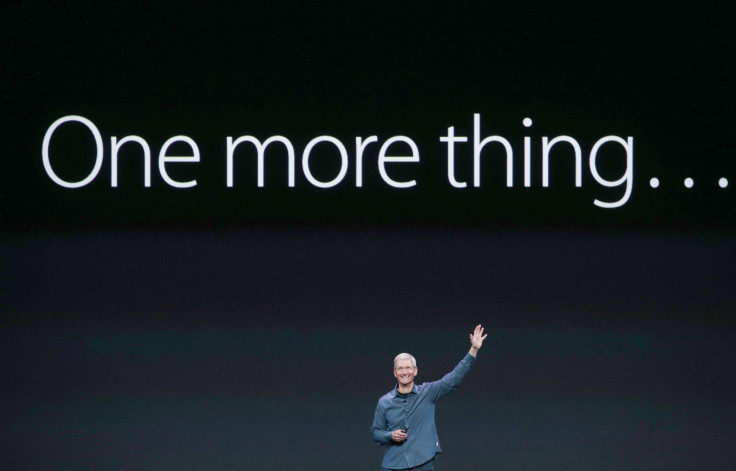Tim Cook Shows Apple Can Be 'Classic Apple' Once More

Apple Inc. (NASDAQ:AAPL) wouldn't be Apple if it didn't create new markets and devices that transcend staid consumer electronics and inhabit a singular place in the culture. So, the question going into its big event in Cupertino, California, Tuesday was a version of: Can Apple be Apple again?
CEO Tim Cook had the burden of succeeding Apple’s larger-than-life co-founder Steve Jobs, but he showed today he’s not going to be a caretaker leader. He’s not Steve Ballmer to Microsoft’s Bill Gates. Rather, he managed to meet enormously high expectations for the company while providing the stagecraft Apple’s legions of fans have come to expect.
“This was both classic Apple and future Apple,” Forrester analyst James McQuivey said. “Apple is not just about great hardware or great software; its the way they pull them together in an elegant experience. This is what Apple is known for but hasn’t done lately.”
Going into today’s media event, Apple hadn’t really introduced a truly new product since the iPad in 2010; indeed, in the intervening years since the death of Jobs it's been about faster, thinner phones, Macbooks and iPads. But today it unveiled a product -- the Apple Watch -- that has the potential to create a new category, as well as a feature -- Apple Pay -- which could finally solve payments mostly because of the impressive array of retail and credit card company partners.
This is classic Apple: Before iPod there were plenty of mp3 players; before iPhone, a great many smartphones, and before iPad, many attempts at tablets. Today, the wearables market is a disjointed array of devices, almost beta versions of devices that have come out in the past few years. Motorola and Samsung have made interesting devices with Motorola 360 and Galaxy Gear based on Google’s Android Wear, but neither has become must-have or integrated them beautifully into an ecosystem, which is what Apple promises to do with Apple Watch.
Let’s recap what Apple actually did today:
It unveiled bigger, better smartphones. The iPhone 6 and iPhone 6 Plus nicely reassert Apple’s place at the very top of the smartphone food chain. With bigger displays, payments functionality, faster processors and useful features, they’re significant improvements compared to the prior generation of iPhones. “The new sizes should help feed into what should be a strong upgrade cycle in the U.S.,” BTIG Research analyst Walter Piecyk said.
Apple took on the payments morass. The highway is littered with failed attempts to crack payments, but Apple managed to get the credit card issuers and retail partners on board for a service that could make you want to ditch your wallet. This is also classic Apple: behind many of its great services is a transformative business deal, kind of like convincing the labels to sell songs for 99 cents. If Apple Pay really works the way Cook says it will (take a picture of your card, touch to pay) it seems revolutionary. Did it meet expectations? “I think with the Apple Pay, it actually exceeded it,” Recon Analytics analyst Roger Entner said. “I think that will be what is really the shining star in the series of announcement.”
Finally, it created a category. The Apple Watch looks like the kind of product that could mainstream wearables and make a host of current entries from Motorola, Samsung running Google’s Android Wear just seem consumer electronics made by consumer electronics companies, not a piece of personal tech about which one could form feelings. “That’s something above and beyond the technology,” said Daniel Ladik, associate professor of marketing at Seton Hall University. “They’re actually thinking about how us as users really want to communicate and figured out how to accomplish it.”
Some huge caveats on this: Apple said nothing about battery life, a problem that has afflicted the current crop of wearables on the market, or whether the device will be water- and/or dust-proof.
When Cook was setting up marketing head Phil Schiller to unveil the iPhones, he had the look of a guy who had a lot more up his sleeve, and it turns out he did. Jan Dawson, founder and head of Jackdraw Research, said the two versions of the iPhone 6 alone are enough to drive Apple’s biggest-ever fourth quarter. “The iPhone is the biggest thing in the short term, and will make for a massive quarter and year,” he said. “But the Apple Watch is a bigger deal long term because it's going to create a huge new opportunity.”
And one other thing, Apple banished the tired and now over-used “i” from product names, with Apple Watch and Apple Pay. Headline writers and grammarians approve.
One last caveat. Cook has spoken with considerable passion about how he wants Apple to become a more diverse company and that he's “not satisfied” with the numbers its recently released report. Yet again Apple managed to put on an event without a single female present, other than to model or demonstrate products.
Apparently that's a harder problem to solve than bigger phones, wearables or payments. Let's hope that's on the product road map for 2015.
Contributing: Luke Villapaz, Thomas Halleck, Dylan Love and Jeff Stone.
© Copyright IBTimes 2024. All rights reserved.





















